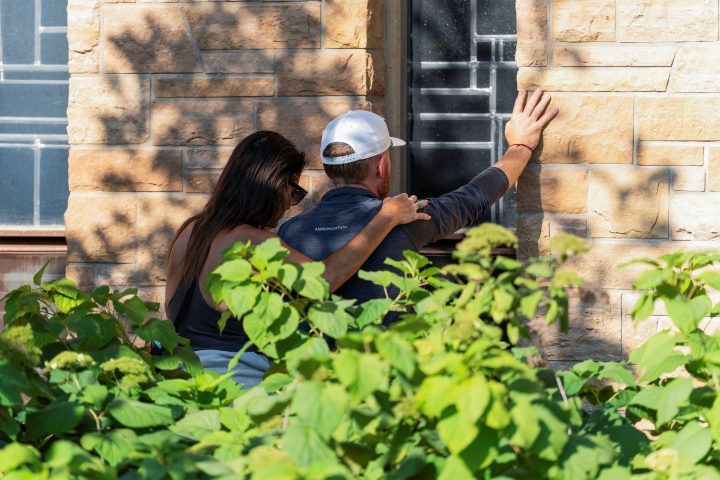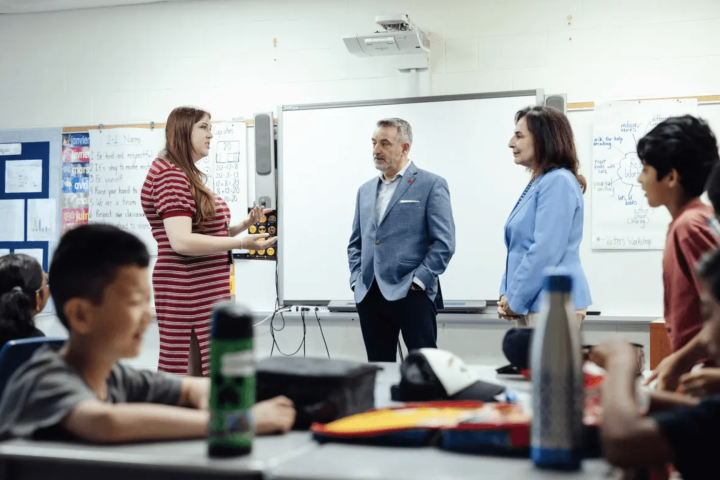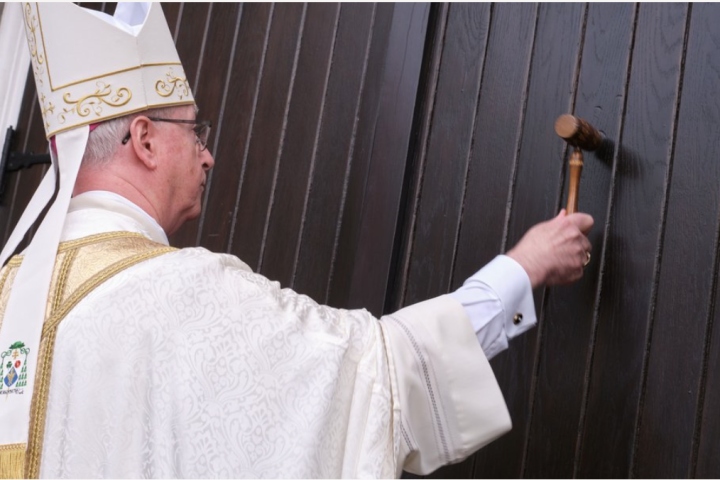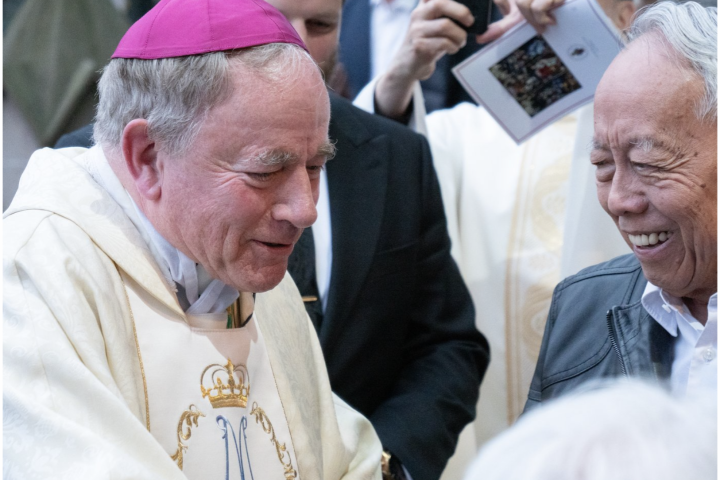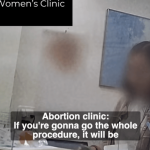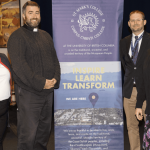When it comes to supporting Catholic education, the audience that came to hear Father Deacon Andrew Bennett’s fundraising talk for Catholic Pacific College was as committed as it gets.
By the time he had finished, however, they were not only aware of how much Canada needs inspired Catholic young people, but they could also see the path toward developing them: through truth and beauty.
Canada’s first Ambassador for Religious Freedom, the ordained deacon (referred to as Father Deacon in his Ukrainian Catholic tradition), began his talk by dissecting Statistics Canada numbers that shed light on the country’s religious attitudes. He admitted things look troubling, with only 16 per cent of Canadians claiming to be religiously committed – regularly attending services, reading sacred texts, and educating their children in their religious tradition.
A similar number are “privately faithful,” believing in God but not attending services or reading Scriptures.
Another 19 percent are non-religious, which means they may or may not believe in God and do little in their lives about it.

“Then you’ve got 43 per cent, more or less, whom we call the spiritually uncertain,” said Father Deacon Bennett: “a little yoga one week, a little chicken soup for the agnostic soul the next week, and a little Pentecostal revivalism the following week. These are the ‘seekers,’ we’ll call them.”
Finally, he gets to Catholics, who, according to Statistics Canada, make up 28 per cent of the population in Canada.
Despite their numbers, just nine percent go to Mass regularly.
“That is the current rate of Mass attendance in this country,” he said. “Nine per cent.”
Probing more deeply, matters get more concerning. Asked whether “God and religion should be kept out of public life,” 68 per cent of Catholics respond yes.
In contrast, only 65 per cent of Canadians as a whole feel the same way, he adds.
In addition, less than half of Catholics are willing to acknowledge their faith publicly – compared to 55 per cent of Protestants and 83 per cent of Evangelical Protestants.
There also isn’t much good news when it comes to Canadians’ attitudes toward Catholicism in general: 24 per cent of Canadians under the age of 40 believe that Catholicism is damaging Canada and Canadian society.
“These are troubling numbers, to say the least,” Father Deacon Bennett told the crowd.
On the other hand, he said, “We are of the Resurrection,” and as we live out our baptism, “we always have hope.”
To have hope requires paying attention to what is going on and “recognizing that it is not I who am in control,” he said.
Christ is the Saviour, and “he is the one to whom I’ve joined myself in my baptism. And so, I have a responsibility as a faithful Catholic to do his work in the world.”
That work includes observing positive signs in society. For example, 18 per cent of Canadians aged 18 to 34 claims to be religiously committed, slightly more than the Canadian average and precisely the age range of students at Catholic Pacific College.
“So, what’s going on?” Father Deacon Bennett asked, before offering an explanation.

“I think increasingly young adults see what the world is offering them, and they realize it’s not what they want. They realize that it’s very transient. It’s not especially authentic; it’s very shallow. It’s all about them. There’s no transcendence.”
In short, a positive social reality in Canada is being overlooked.
“Certainly, the mainstream media doesn’t talk about it, and I don’t even think in our churches we necessarily know that this is going on.”
But in his conversations with Christian faith leaders across the country, most agree that “there’s something happening in that 18- to 34-year-old cohort.”
He shared the stories of two young people he knows whose lives testify to that reality.
Rory was a student at Ottawa’s Augustine College, where Father Deacon Bennett was dean and teaching Church history. The young man had a Christian background but no active faith life. What he had, however, was a love of singing that led him to accompany friends to a choir at a Ukrainian Catholic church. Soon he was joining them in singing the Slavic Byzantine repertoire.
Father Deacon Bennett described Rory’s first experience at choir practice in the darkened church. He would gaze at the icons on the walls. Before long, he was attending Sunday Divine Liturgy.
“There was Rory just looking around; he’d never seen anything like this,” Father Deacon Bennett said.
Rory attended faithfully, although he couldn’t receive the Eucharist. One day he told his instructor he wanted to become Catholic in the Ukrainian Greek Catholic tradition.
The deacon was eager to hear more about what led Rory to the Catholic faith. “I remember when you first came here; you were just enrapt by the iconography and beauty of the chant. Is that what has brought you to this decision?” he asked.
“No, it’s because of what’s happening on that altar,” the young man replied.
“Here’s a young man who had no background in Byzantine Eucharistic theology or Byzantine liturgy, but he intuitively understood that all of the icons, the beauty of the chant, pointed to that – the Holy Eucharist – and he was hungry for it.”
The young man had been led by “the path of beauty.”
A similar story involved Quinton, who showed up one day as Father Deacon Bennett led a weekly young adult discussion on the Nicene Creed with prayer.
“One Saturday, a young guy comes who I’ve never seen before, and we are talking about some of the high Christology in the central part of the Creed, and I could see his face, and the wheels of his mind were racing.”
Afterwards, Quinton introduced himself. Although baptized Catholic, he hadn’t been raised in the Church and became a self-professed atheist. After studying humanities in university, he began reading Plato, Aristotle, and then St. Anselm and St. Thomas Aquinas.
He had many questions and visited various churches before coming to Father Deacon Bennett, with whom he had “many, many conversations.”
Finally, Quinton asked, “What do I need to do to come back to church?”
Learning that Quinton had been baptized and confirmed, the deacon told him he only needed to make a solemn confession and then could receive the Eucharist.
“He became this amazingly devout, faithful young man who married a Ukrainian Greek Catholic girl.”
After the couple became mainstays at their college chapel church, Father Deacon Bennett asked Quinton what had drawn him back. “He said, ‘It’s the truth, and I wanted the truth.’”

Rory had been drawn by beauty, while for Quinton it was reason. “These two paths of reason and beauty are abundant in the Catholic tradition,” said the deacon. Those who work with young adults need to “form them, to educate them in beauty, nurturing their reason.”
The Church offers a “beautiful depth of tradition” for young people’s desire for truth and authenticity, he said. “We must focus on being holy Catholic and Apostolic in all things that we do, in every aspect of our faith, and in every aspect of our lives. In our sacramental lives, in our liturgical lives, and in our own personal prayer lives, we should always strive for excellence in everything.”
The Church also has to respond to its apostolic call, he said. “We have to innovate, we have to surprise, and we have to be the church fully in the world for the life of the world. We have to, as Catholics, completely rethink how we are active in the world today and do things differently.”
It all comes down to giving young people “a sense of life in beauty, truth, and goodness – those great classic transcendentals. That is what we’re trying to do at Catholic Pacific College.”


